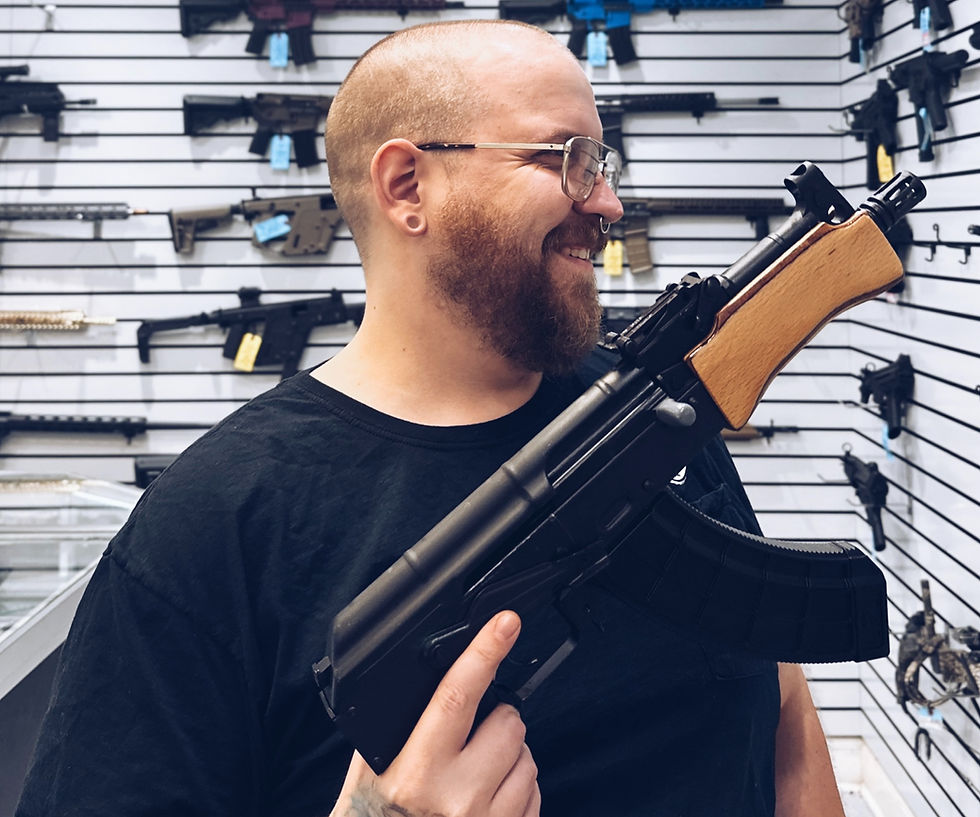Choosing Your Gun: A No-Nonsense Guide to Small Vs. Large Firearms
- X-Ring Staff

- Mar 6, 2024
- 4 min read

Whether it's for personal defense, a job requirement, or for sports, picking the right gun is about finding the balance between size, ease of handling, and performance. Here's a detailed breakdown of the differences between small and large guns to help you make an informed decision.
Size Matters: The Scoop on Small Guns
Small guns—like the Glock 43X or the Smith & Wesson M&P Shield—are often the go-to choice for folks looking for a concealable firearm. But let's dig a little deeper into their characteristics:
Spare Rounds and Strategic Limits: In addition to a compact frame, small handguns often come with magazines that hold fewer rounds. A typical small gun holds between 6 to 10 rounds. It's not a lot, so we often recommend carrying a spare magazine as part of your every day carry (EDC).
Hiding in Plain Sight: The biggest plus of a small gun? It is easy to conceal on your person. Many people are overly worried about "printing" when they first start carrying a concealed firearm. Printing is having a bulge in your clothing that alerts others that you are carrying a firearm concealed under the clothing. While it is important to avoid printing, most new CCDW permit holders put a really high value on this because they are self conscious and choose a gun that is as small as possible. The majority of people pay very little attention to those around them, and are not likely to see a firearm printing unless it is super obvious. Therefore, we typically recommend to carry the largest gun you can comfortably conceal, as it will have better capacity and shoot-ability, which leads us to....
Snap Judgment: Recoil—the kickback you feel when firing—is sharper with small guns. They’re light and easy to carry, but they can be harder to handle when firing multiple shots. This means you’ve got to train more to stay accurate under pressure.
Aiming Issues: Speaking of accuracy, smaller guns are a little harder to shoot straight with at longer distances. This is because they have a shorter barrel and sight radius, which makes aiming less stable. But don’t worry—with practice, your accuracy will improve, and for the close-range use these guns are meant for, they're spot on.
Going Big: The Deal with Large Guns
Now let's talk about bigger guns, like the beefy Glock 17 or the classic Colt 1911. These guns mean business and bring some big-time benefits to the table:
Loaded for Longer: If you’re looking for more firepower, big guns are your answer. They often hold more than 15 rounds. This means less worrying about running out of bullets in situations that may need more shooting, like competitive sports or if you’re ever in a really bad spot with multiple attackers.
Concealment Challenge: Sure, they're harder to hide because of their size. This means you’ll have to be more thoughtful about how you dress and where you carry. Big guns might require special holsters or carrying methods to keep them out of sight. For most people, this is minor obstacle to overcome and is worth it for the increased capabilities of a larger firearm.
Smooth Operator: A big gun's weight helps absorb the recoil. This means shooting with a big gun feels steadier, and you’re more likely to stay accurate for follow-up shots. It's like the difference between riding a big, heavy motorcycle and a lightweight scooter—the bigger one feels less bumpy.
Long-Distance Dial In: With a bigger gun, you've got a steadier hand and better aim for targets that are further off. Bigger guns are built to help you shoot more accurately from a distance. They have a longer barrel, which gives you a more stable shot line. This makes them a good choice for any situation where distance is a factor, like certain self-defense scenarios or target shooting at a range.
All Things Considered: Making the Choice
Choosing a gun isn't as simple as picking the biggest or the smallest. It’s about knowing what you need it for, how you want it to feel in your hand, and how much you need to conceal it.
For day-to-day carrying where discretion is key, smaller guns are unbeatable. They're comfortable, light, and won't make it obvious that you're armed. But you'll need to practice handling their recoil and perfecting your close-range aim.
For those who value steady shots and the need to shoot accurately at longer distances, large guns are the better choice. Yes, they're more challenging to hide, but their size and weight make them more manageable to shoot, which could be a lifesaver in a tense scenario.
In the end, understanding the intricacies of each firearm—its quirks, its demands, and its rewards—is a personal journey. Entering this realm with knowledge, respect, and dedication will ensure that whichever size you choose, your gun will be a true companion—ready and reliable when it matters most.
So the best advice is to try different guns. Visit a range, handle various models, and get a real feel for what suits you. And once you've picked a gun, practice is key. The more familiar you are with how your gun handles, the safer and more effective you'll be, no matter its size.







Comments